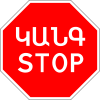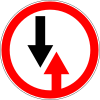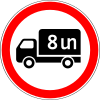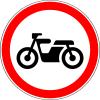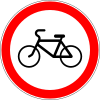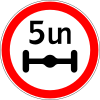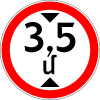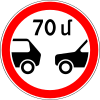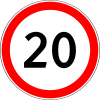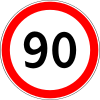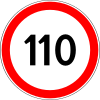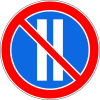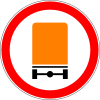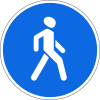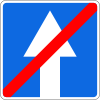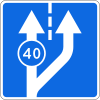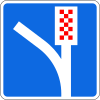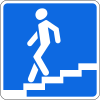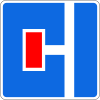
Road signs in Switzerland and Liechtenstein generally conform to the 1968 Vienna Convention on Road Signs and Signals.

Road signs in Mauritius are standardised traffic signs used in Mauritius according to the Traffic Signs Regulations 1990. They are heavily modelled on road signs in the United Kingdom, since Mauritius is a former British colony and drives on the left.
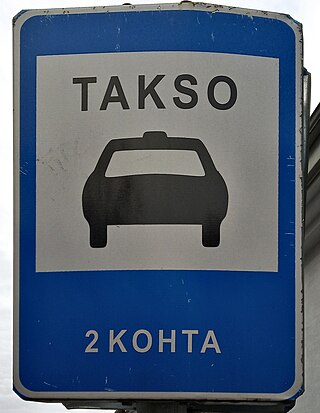
Road signs in Estonia ensure that transport vehicles move safely and orderly, as well as to inform the participants of traffic built-in graphic icons. These icons are governed by the Vienna Convention on Road Traffic and Vienna Convention on Road Signs and Signals. The system is covered in Liiklusmärkide ja teemärgiste tähendused ning nõuded fooridele and the standards document EVS 613:2001 Traffic signs.

Bosnia and Herzegovina is a signatory to the Vienna Convention on Road Signs and Signals. Therefore, road signs do not differ much from the rest of Europe, such as Croatia, Slovenia, Serbia and North Macedonia. Ministry of Transportation of Bosnia and Herzegovina regulates them. Bosnia and Herzegovina drives on the right as with the rest of Europe, except for Cyprus, Ireland, Malta and the United Kingdom. Bosnian and Herzegovinan road signs have two scripts, Latin and Cyrillic script.
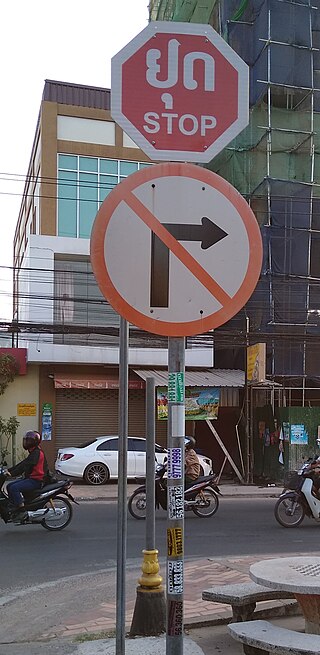
Road signs in Laos generally follow those used in most European countries as set out in the Vienna Convention on Road Signs and Signals. Despite this, the country itself has never signed the Vienna Convention on Road Signs and Signal. Inscriptions on traffic signs are in Lao, the national language of Laos. However, English is also used for stop and important public places such as tourist attractions, airports, railway stations, and immigration checkpoints. Both Lao and English are used on directional signage.
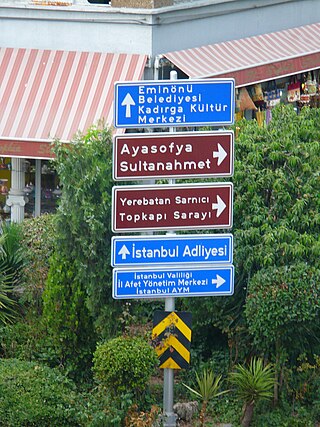
Turkey conform to the general pattern of those used in most other European countries and set out in the Vienna Convention on Road Signs and Signals. They are regulated by the Trafik İşaretleri Elkitabi.

Road signs in Azerbaijan are similar to the road sign system of post-Soviet states that ensure that transport vehicles move safely and orderly, as well as to inform the participants of traffic built-in graphic icons. They generally conform to the Vienna Convention on Road Traffic and Vienna Convention on Road Signs and Signals.
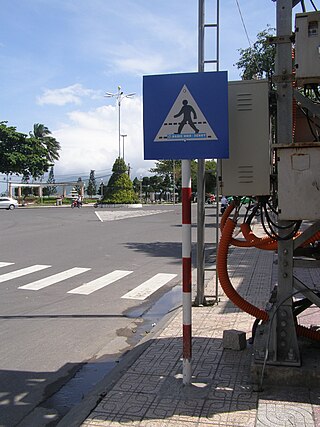
Road signs in Vietnam follow Chinese and French road signs. Some signs are written in both Vietnamese and English. The signs are prescribed by the Ministry of Transportation of Vietnam.

Road signs in Mongolia are similar to the Soviet, British, and other European road sign systems. Road signs are regulated in the MNS 4597:2014 standard and conform to the general pattern of road signs as set out in the Vienna Convention on Road Signs and Signals. Despite the fact that Mongolia was never part of the Soviet Union, the MNS 4597:2014 standard for road signs has many similarities with its post-Soviet counterparts based on the Soviet standard ГОСТ 10807-78 and the Russian standard ГОСТ Р 52290-2004. Mongolia acceded to the Vienna Convention on Road Signs and Signals on December 19, 1997.

Road signs in Georgia are similar to the road sign system of other post-Soviet states that ensure that transport vehicles move safely and orderly, as well as to inform the participants of traffic built-in graphic icons. However, some road signs look a bit different from Soviet ones and closer to the European ones. These icons are governed by the Vienna Convention on Road Traffic and Vienna Convention on Road Signs and Signals.

Road signs in Kazakhstan are similar to the road sign system of other post-Soviet states that ensure that transport vehicles move safely and orderly, as well as to inform the participants of traffic built-in graphic icons. These icons are governed by the Vienna Convention on Road Traffic and Vienna Convention on Road Signs and Signals. Road signs are regulated by the СТ РК 1125-2021 standard.

Road signs in Kyrgyzstan are similar to the road sign system of other post-Soviet states that ensure that transport vehicles move safely and orderly, as well as to inform the participants of traffic built-in graphic icons. These icons are governed by the Vienna Convention on Road Traffic and Vienna Convention on Road Signs and Signals.

Road signs in Uzbekistan are regulated by the O'zDst 3283-2017 standard. Due to the country being a former Soviet Socialist Republic between 1924 and 1991, road signs are similar in design to those used in the Soviet Union before its dissolution in 1991, as well as in most other post-Soviet states. Uzbekistan acceded to the Vienna Convention on Road Signs and Signals on January 17, 1995. The Soviet Union itself was once a signatory to the Vienna Convention on Road Signs and Signals.

Road signs in Lithuania conform to the general pattern of those used in most other European countries as set out in the 1968 Vienna Convention on Road Signs and Signals. Due to the country being occupied and annexed by the Soviet Union between 1940 and 1990, when it restored its independence, modern road signs used in Lithuania are in many ways similar in design to road signs used in the Soviet Union before its dissolution in 1991. This design of road signs is still used in most post-Soviet states, in particular Russia, Belarus, and Ukraine. Neighboring post-Soviet Baltic countries Latvia and Estonia, which were also occupied by the Soviet Union in 1940, have significantly modified their road sign designs, resulting road signs in these two countries being extremely different in design from road signs used in most other post-Soviet states.

Road signs in Russia are governed by the traffic rules approved by the Decree of the Government of the Russian Federation No. 1090 of 23 October 1993 “On the Rules of the Road”, Appendix 1 “Road Signs”. They are regulated by the ГОСТ Р 52289-2019 and ГОСТ Р 52290-2004 standards determining the rules for the use and production of road signs. The vast majority of road signs used in Russia were in the preceding Soviet standard ГОСТ 10807-78, which was introduced in the Soviet Union on 1 January 1980 before its dissolution in 1991 and is no longer valid in Russia since 1 January 2006 after it was replaced by the modern standard ГОСТ Р 52290-2004 for road signs. Road signs generally conform to the Vienna Convention on Road Signs and Signals. Similar road signs are also used in other post-Soviet states.
Road signs in Latvia conform to the general pattern of those used in most other European countries. They are regulated in Ceļu satiksmes noteikumi and the standards documents LVS 77–1:2016 "Ceļa zīmes. 1. daļa: Ceļa zīmes", LVS 77-2:2016 "Ceļa zīmes. 2. daļa: Uzstādīšanas noteikumi" and LVS 77-3:2016 "Ceļa zīmes. 3. daļa: Tehniskās prasības" in conformity with the 1968 Vienna Convention on Road Signs and Signals. Latvia acceded to the Vienna Convention on Road Signs and Signals on October 19, 1992.

Road signs in South Africa are based on the SADC-Road Traffic Sign Manual, a document designed to harmonise traffic signs in member states of the Southern Africa Development Community. Most of these signs were in the preceding South African RTSM.

Road signs in Tajikistan are similar to the signs of other post-Soviet states and most European road sign systems. Like all post-Soviet states, Tajikistan is a signatory to the Vienna Convention on Road Traffic and the Vienna Convention on Road Signs and Signals. Order of the Government of the Republic of Tajikistan of June 29, 2017 No. 323 "About Traffic regulations" regulates road signs and markings. Road signs ensure transport vehicles move safely and orderly, as well as, to inform both pedestrians and motorists of traffic rules. Images of road signs are mostly based on the Soviet ГОСТ 10807-78, Belarusian СТБ 1140-2013 and Russian ГОСТ Р 52290-2004 standards.

Road signs in Belarus are regulated by the СТБ 1140-2013 standard. Due to the country being a former Soviet Socialist Republic between 1920 and 1991, road signs are similar in design to those used in the Soviet Union before its dissolution in 1991, as well as in most other post-Soviet states, especially neighboring Russia and Ukraine. Like Russia and Ukraine, Belarus is a signatory to the Vienna Convention on Road Traffic and the Vienna Convention on Road Signs and Signals. Belarus signed the Vienna Convention on 8 November 1968 and ratified it on 18 June 1974, when it was a Soviet Socialist Republic. The Soviet Union itself was once a signatory to the Vienna Convention on Road Signs and Signals.

Road signs in the Soviet Union were regulated in the ГОСТ 10807-78 standard which was introduced on 1 January 1980. This standard also specified the typeface used on road signs. After the dissolution of the Soviet Union in 1991, this standard continued to apply in all countries that were formerly Soviet republics until some of them adopted their own national standards for road signs. The shapes and colors of road signs in the Soviet Union, and now in all post-Soviet states, fully comply with the 1968 Vienna Convention on Road Signs and Signals, to which the Soviet Union was originally a signatory. On 8 November 1968, the Soviet Union signed the Vienna Convention on Road Signs and Signals, and on 7 June 1974 ratified it with some declarations and reservations made upon ratification.





















































